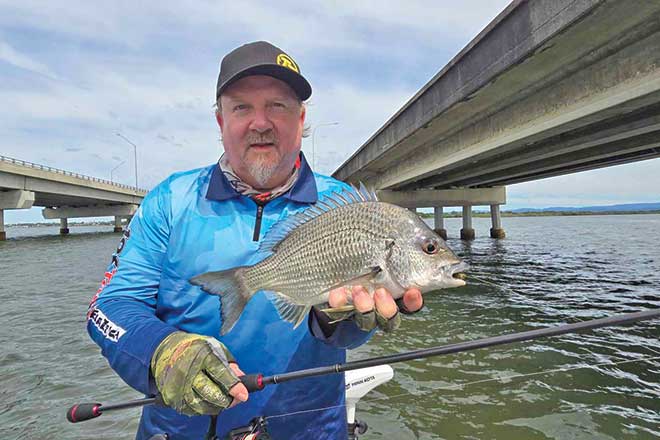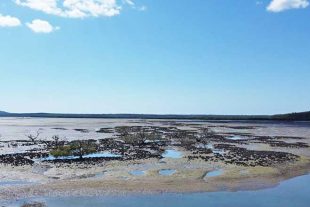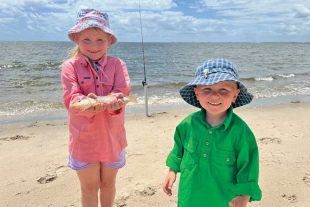There are many old sayings in fishing that still ring true and one of those is ‘find the structure, find the fish’.
Available structure for anglers includes natural environments such as mangroves, lilies, timber and channel edges, as well as manmade construction such as boat ramps, pontoons, stormwater drains and rock walls.
Very productive manmade structures – and the focus of this article – are bridges.
I’ll be covering these together with the gear and techniques that will get you the bites.
Wherever we find rivers and creeks, we’ll generally find bridges that allow pedestrians, cyclists, cars, trains and other vehicles to travel safely over these waterways.
You will often find access points to fish land based around bridges or to launch a kayak or canoe to explore the area further.
If you’re new to a system, bridges are a great starting point to find fish because the pylons and other structure that support the bridge also alters the water flow and provides shelter and ambush points for fish.
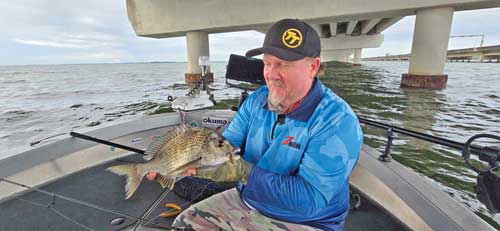
Eddies and pressure points
When approaching bridges, it’s important to think about where the fish might be holding on the pylons and why.
As water flows past a bridge pylon, it creates an eddy behind it and this break in flow is where you will often find bait holding, and in turn predators holding and feeding.
Working your way along the bridge and fishing the eddies can be very productive, however the water flow also creates another key strike zone – pressure points.
Pressure points will form in front of the pylon, where the water is forced to divert around the structure, before creating an eddy behind it.
It’s worth making the occasional cast into the pressure points as we’ve often found bream, trevally, tailor and other species holding and feeding in these areas.
As with all angling, fishing bridges is all about cracking the pattern on the day, working out where the fish are holding and what they are feeding on.
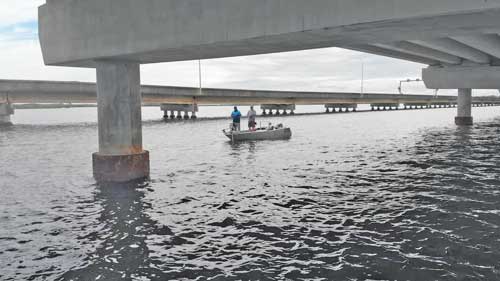
Top to bottom
Pylons provide vertical structure that can make them trickier to fish when compared to a weed or channel edge.
It’s important to remember that this vertical structure could hold fish at any depth, so we prefer to vary our retrieves and presentations to fish from the surface to the base of the pylons.
Bridges also offer an incredible mix of species, from bread-and-butter fish such as bream and flathead to pelagic such as tailor, trevally and mackerel, plus reef varieties such as snapper and sweetlip emperor.
Soft plastics are an effective choice because a single plastic can be rigged on different weighted jig heads to fish the entire depth, with a TT hidden weight system an option for targeting bream mooching around the tops of the pylons, increasing the weight to reach the required depths based on the flow.
Lifting and lowering the rod tip and increasing and decreasing retrieve speeds can also allow you to adjust the running depth of your presentation to ensure it is in the strike zone when it enters the eddy or pressure point.
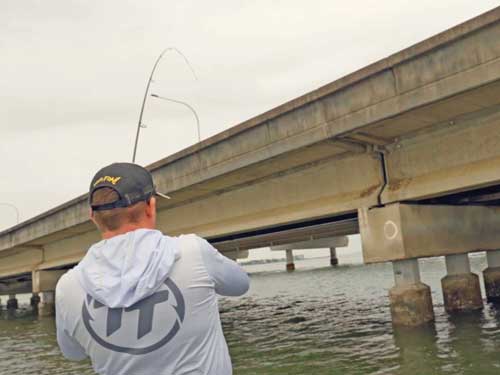
End to end
Some bridges will be short with only a handful of pylons, while others will span much larger areas, with rows of structure to explore.
It’s important to remember that over the span of the bridge, the environment can change radically, so it’s worth exploring the length of the bridge, particularly if you have a depth sounder and can make a note of water depth, bottom structure, bait and fish.
Again, it’s all about cracking the pattern in terms of the species, key bite times and what they’re feeding on.
Certain sections of the bridge may fish better on different stages of the tide and various tide sizes may hold a mix of species and offer many depths for utilising varying techniques.
The pylons are the key structure.
However, some will hold more fish and the effectiveness of a particular pylon could be multiplied by its additional marine growth, water depth or proximity to variables such as heavy flow, channel edges or supporting structure – weed beds or rubble piles created during the original construction of the bridge and sinking of the pylons.
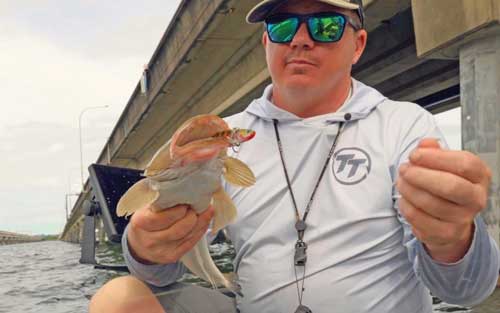
Other variables
A couple of other variables that can dictate what sections of the bridge can be more effective include water quality, shade and wind direction.
Across the span of larger bridges, you may encounter varying wind, bottom structure, current and water depth, all of which can alter the water clarity and the amount of suspended sediment.
If the bite is not happening, try moving to cleaner or dirtier water, as this can sometimes impact the species holding in the area and how aggressively they’re feeding.
Regardless of the type of structure you’re fishing – including mangroves, pontoons and bridges – shade often hold fish.
Maybe predators use these shade areas as an ambush point or perhaps they feel safer holding in the shadows.
Regardless, get a cast into the shadowy areas, especially when fishing shallower water, and you may find yourself hooked up.
Finally, the position of the bridge in relation to wind, sun and flow also often dictates which pylons will hold more fish.
You could work your way across the length of a bridge fishing the ocean side pylons without many bites, only to move to the inside pylons and find them stacked with fish, due to one or more of the variables mentioned.
So, if the bite isn’t happening, make it happen by switching pylon lines, moving along the expanse of the bridge or varying the depth you’re fishing on the pylons.
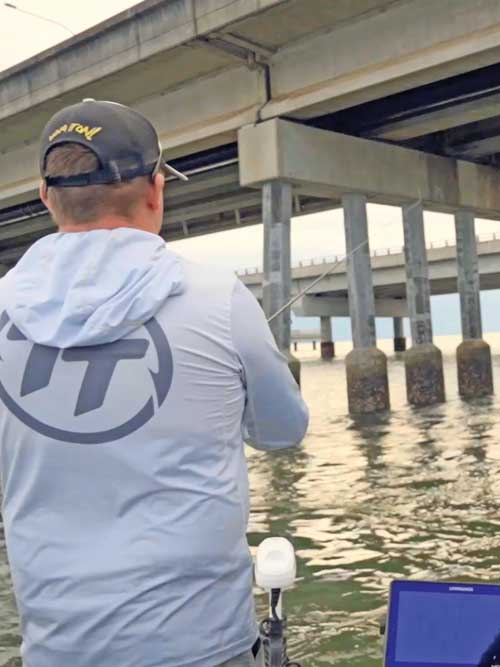
Go-to combos
When it comes to fishing bridges, primarily I have three combos rigged, depending on the type of fishing I’m doing and the key target species.
Light
A 7’0” 1-3kg spin rod and 1000 reel loaded with 6lb braid and 10lb leader is great fun for delivering lighter presentations, including jig heads to around 1/20oz to 1/8oz.
This is my go-to combo when targeting bream, and you may find yourself doing some fancy rod work if a trevally or larger predator decides to eat your presentation.
Medium light
A 7’0” 2-4kg spin rod and 2500 reel loaded with 8-10lb braid and 10lb leader is a great all-rounder for fishing the river and estuary, including bridge fishing.
I use this combo to cast plastics on jig heads to about 1/4oz, as well as fishing blades and small vibes.
This combo will handle most species encountered when fishing bridges.
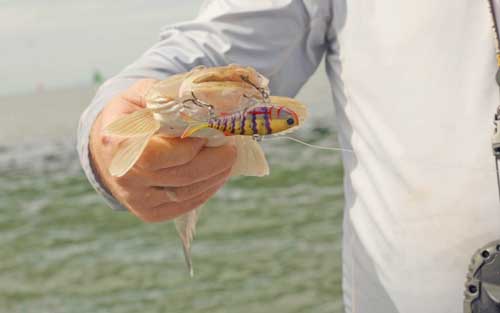
Medium
A 7’0” 3-6kg spin rod and 2500-3000 reel loaded with 10-15lb braid and 10-20lb leader will handle a lot of the heavier work, including fishing deeper water with jig heads to 3/8oz and working larger soft vibes.
I use this combo mostly for fishing the deeper channel sections that the bridge spans and when targeting larger species such as snapper and mulloway.
Target species and lure presentation will generally dictate the combo selected and you may need to upsize the setup based on this, however these three have served me well when fishing bridge structure for commonly targeted species.

Go-to presentations
There are a stack of lure presentation types that are effective when fishing bridges, however I wanted to touch on a couple of my proven favourites.
The environment can change dramatically when fishing bridges, including the depth, current, target species and where they’re holding.
Consequently, I love the versatility of soft plastics, and that by changing the weight of the jig head, I can fish the same plastic throughout the entire water column.
So, let’s start with plastics.
Often, you’ll find a concentration of small baitfish holding around the pylons.
My favourite imitation is a Z-Man 2.5” Slim SwimZ, a small baitfish profile with loads of action that appeals to a wide range of species.
Prawns frequently hold around bridges, so with my go-to being the Z-Man 2.5” PrawnZ and if prawns are active in the system, everything will eat this bite-sized snack.
I fish both on a size 1 or 1/0 TT jig head, with 1/20oz, 1/8oz and 1/4oz weights carried as a minimum, which will cover bream mooching around the tops of the pylons to a slow fall for a mix of species and a heavier head to get down to the base of the pylons in reasonable depth and flow.
When the bait is larger, it’s hard to beat the proven Z-Man 3” MinnowZ for versatility.
Rigged on a 1/8oz 3/0 TT HeadlockZ HD jig head for shallow water, stepping to a 1/4oz and 3/8oz as the water gets deeper or the flow increases.
Another favourite for fishing deeper water and increased flow is the TT Quake soft vibe, with the 75mm a go-to for a mixed bag of species and the 95mm a favourite for mulloway and threadfin salmon.
Fish on!
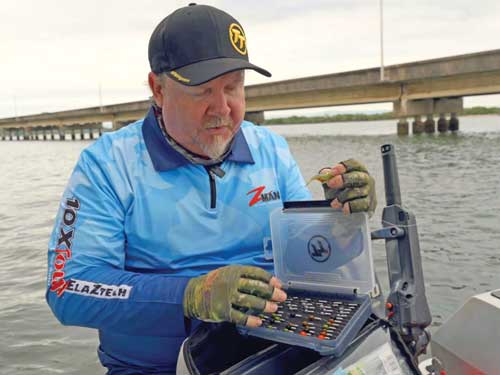
Now it’s time to get those casts tight to the pylon or past the pylon and back with the flow, so that your lure presentation enters the strike zone at the desired depth.
Keep an eye on your line and be ready for a bite as the lure sinks.
Fish that are holding around the pylons are commonly there to feed, so a lure wafting down with the current is often an easy target.
The strike zone is generally close to the pylon, with a few twitches or hops, or a shaking retrieve often all that’s required to entice the bite, while keeping the lure in the strike zone for longer.
If you’re fishing with other anglers, try fishing a variety of presentations and retrieves until you start to crack a pattern.
If one angler hooks up, it can be worth keeping an eye on the hooked fish to see if it has other fish with it because a hooked fish will often draw other fish away from the pylon, keen to get their teeth into whatever their friend is eating.
This can lead to some fun double hook-ups on bream, trevally, tailor and other species that school around the pylons hunting bait.
There are plenty of bridges out there to fish, so jump onto Google Maps to check out the concrete and steel fish-holding structure available in the areas you fish, get a cast in there and hang on!
See you on the water.
 Bush ‘n Beach Fishing Magazine Location reports & tips for fishing, boating, camping, kayaking, 4WDing in Queensland and Northern NSW
Bush ‘n Beach Fishing Magazine Location reports & tips for fishing, boating, camping, kayaking, 4WDing in Queensland and Northern NSW

